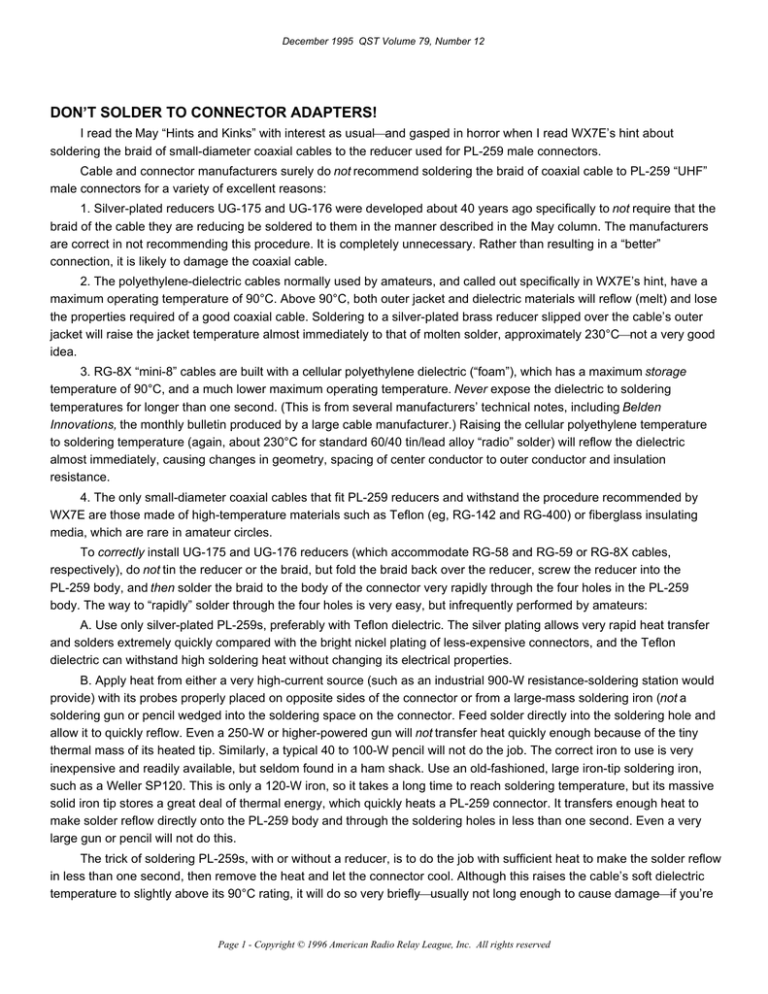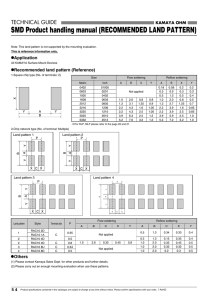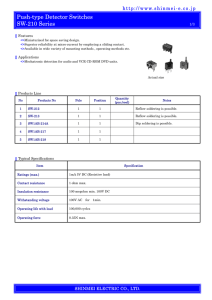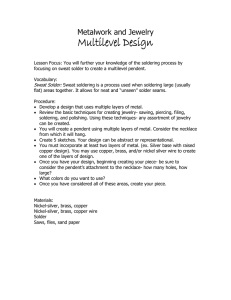
December 1995 QST Volume 79, Number 12
DON’T SOLDER TO CONNECTOR ADAPTERS!
I read the May “Hints and Kinks” with interest as usualand gasped in horror when I read WX7E’s hint about
soldering the braid of small-diameter coaxial cables to the reducer used for PL-259 male connectors.
Cable and connector manufacturers surely do not recommend soldering the braid of coaxial cable to PL-259 “UHF”
male connectors for a variety of excellent reasons:
1. Silver-plated reducers UG-175 and UG-176 were developed about 40 years ago specifically to not require that the
braid of the cable they are reducing be soldered to them in the manner described in the May column. The manufacturers
are correct in not recommending this procedure. It is completely unnecessary. Rather than resulting in a “better”
connection, it is likely to damage the coaxial cable.
2. The polyethylene-dielectric cables normally used by amateurs, and called out specifically in WX7E’s hint, have a
maximum operating temperature of 90°C. Above 90°C, both outer jacket and dielectric materials will reflow (melt) and lose
the properties required of a good coaxial cable. Soldering to a silver-plated brass reducer slipped over the cable’s outer
jacket will raise the jacket temperature almost immediately to that of molten solder, approximately 230°Cnot a very good
idea.
3. RG-8X “mini-8” cables are built with a cellular polyethylene dielectric (“foam”), which has a maximum storage
temperature of 90°C, and a much lower maximum operating temperature. Never expose the dielectric to soldering
temperatures for longer than one second. (This is from several manufacturers’ technical notes, including Belden
Innovations, the monthly bulletin produced by a large cable manufacturer.) Raising the cellular polyethylene temperature
to soldering temperature (again, about 230°C for standard 60/40 tin/lead alloy “radio” solder) will reflow the dielectric
almost immediately, causing changes in geometry, spacing of center conductor to outer conductor and insulation
resistance.
4. The only small-diameter coaxial cables that fit PL-259 reducers and withstand the procedure recommended by
WX7E are those made of high-temperature materials such as Teflon (eg, RG-142 and RG-400) or fiberglass insulating
media, which are rare in amateur circles.
To correctly install UG-175 and UG-176 reducers (which accommodate RG-58 and RG-59 or RG-8X cables,
respectively), do not tin the reducer or the braid, but fold the braid back over the reducer, screw the reducer into the
PL-259 body, and then solder the braid to the body of the connector very rapidly through the four holes in the PL-259
body. The way to “rapidly” solder through the four holes is very easy, but infrequently performed by amateurs:
A. Use only silver-plated PL-259s, preferably with Teflon dielectric. The silver plating allows very rapid heat transfer
and solders extremely quickly compared with the bright nickel plating of less-expensive connectors, and the Teflon
dielectric can withstand high soldering heat without changing its electrical properties.
B. Apply heat from either a very high-current source (such as an industrial 900-W resistance-soldering station would
provide) with its probes properly placed on opposite sides of the connector or from a large-mass soldering iron (not a
soldering gun or pencil wedged into the soldering space on the connector. Feed solder directly into the soldering hole and
allow it to quickly reflow. Even a 250-W or higher-powered gun will not transfer heat quickly enough because of the tiny
thermal mass of its heated tip. Similarly, a typical 40 to 100-W pencil will not do the job. The correct iron to use is very
inexpensive and readily available, but seldom found in a ham shack. Use an old-fashioned, large iron-tip soldering iron,
such as a Weller SP120. This is only a 120-W iron, so it takes a long time to reach soldering temperature, but its massive
solid iron tip stores a great deal of thermal energy, which quickly heats a PL-259 connector. It transfers enough heat to
make solder reflow directly onto the PL-259 body and through the soldering holes in less than one second. Even a very
large gun or pencil will not do this.
The trick of soldering PL-259s, with or without a reducer, is to do the job with sufficient heat to make the solder reflow
in less than one second, then remove the heat and let the connector cool. Although this raises the cable’s soft dielectric
temperature to slightly above its 90°C rating, it will do so very brieflyusually not long enough to cause damageif you’re
Page 1 - Copyright © 1996 American Radio Relay League, Inc. All rights reserved
December 1995 QST Volume 79, Number 12
careful. It’s a good idea to not move or disturb the cable or connector for about one minute after soldering, so that the
dielectric can reform to its original state.
My company installs PL-259 connectors, with and without reducers, at an average rate of about 500 per month, so
we probably install more of these in three months than most hams do in a lifetime. After each installation, we evaluate the
assembly by checking SWR at 300 MHz and also performing a “hipot” (high-potential, dielectric withstanding voltage) test
at the maximum voltage rating for the cable being used. With careful workmanship, well-trained operators and the special
techniques described here, we get about 99% yield on completed assemblies. This means we still throw about a half
dozen connectors in the trash each month. With the technique described by WX7E (we’ve tried it), our yield drops to
below 35%.Steve Katz, WB2WIK/6, Vice President of Engineering, S&S Cable Co, Northridge, California
Page 2 - Copyright © 1996 American Radio Relay League, Inc. All rights reserved




